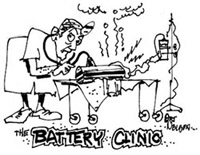First, let's define "fast charge". The industry standard is any charge rate that will
charge the cells in 1 hour or less.
This fast charge capability thing is very interesting. Almost all ni-cds manufactured
today for R/C systems can accept fast charge (up to C rate, that's the rate at which you can charge the cells in approximately
one hour). Cells that are specifically sold as fast chargeable go through another step in the process. This step involves
charging a sample from the production lot and then measuring the end of charge voltage. Cells with the highest end of charge
voltage are then analyzed for internal pressure. If the internal pressure is acceptable, that is not above a preset limit,
the whole production lot is "blessed" as being fast chargeable. Of course this adds a finite amount of cost to the
cell as they must be "formed" prior to being ship in order to be fast chargeable.
Cells not destined for
fast charge applications are shipped "unformed" by some manufacturers. Forming the cell is the process of the first
charge after it is assembled. Nothing more, nothing less. When you charge your R/C system packs for the first time you are
"forming" them. This is why you see the instructions telling you to charge the packs for 16 to 24 hours before you
first use the system. Some manufacturers ship all their cells in the formed condition as part of their manufacturing process.
So in most instances you are safe fast charging the R/C packs (transmitter or receiver) on the market if you first
make sure they get a good first cycle formation charge - 24 hours at the slow rate. Where the problems arise is that some
of the fast charge systems available are a little sloppy when it comes to terminating the fast charge, or they are pushing
the cells too hard (higher than the C rate charge) and then damage occurs. As a rule of thumb if you packs are not getting
hot (slightly warm is OK) you are not damaging them in the fast charge process. When pushing too much current into cells not
designed to accept it there is the risk of driving the cells above 1.6 volts (the hydrogen over voltage point) and electrolyzing
the water in the electrolyte and generating hydrogen. This is a cumulative event and repeated fast charge at these rates will
result in sufficient accumulation of hydrogen to cause the cells to vent. When they do vent there is a chance that the chemical
balance will be disturbed and the cell capacity will fade. Understand that the pack may not be fully charged when the fast
charge terminates. It is a good practice, if you are going to fast charge frequently, to top off the packs using the slow
charger. This will bring all cells to the same state of charge and "balance" the pack. Otherwise the cell that is
not fully charged will be the limiting cell on the next discharge. This continues until there is a major unbalance in the
pack and one cell can be driven into reverse (if you don't crash first).
cls 2/97 rev 1-07

